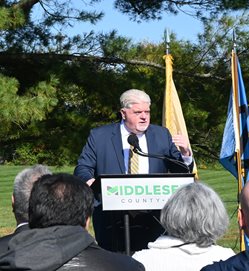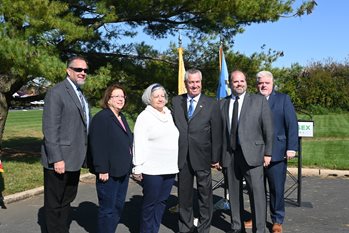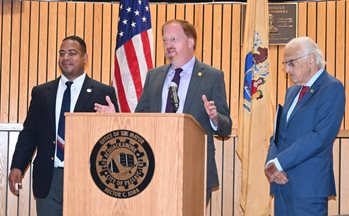October 2023
Posted: 10/26/2023 9:02:47 AM
Middlesex County and Somerset County had the largest growth in electric vehicle (EV) registrations so far this year, leading a trend of growing EV adoption across the NJTPA region and beyond.
.JPG.aspx?width=500&height=333) That was among the insights offered by Zenon Tech-Czarny, Principal Planner, Environmental Planning at NJTPA, in a presentation at a joint meeting of the Project Prioritization and Planning and Economic Development committees on October 16. He highlighted EV data from state and other sources compiled on the NJTPA’s EV Resources hub site.
That was among the insights offered by Zenon Tech-Czarny, Principal Planner, Environmental Planning at NJTPA, in a presentation at a joint meeting of the Project Prioritization and Planning and Economic Development committees on October 16. He highlighted EV data from state and other sources compiled on the NJTPA’s EV Resources hub site.
As of June 2023, there were 128,374 Plug-in Electric Vehicles (PEVs) in New Jersey and almost 100,000 within the NJTPA’s 13-county region, according to the state Department of Environmental Protection’s (NJDEP) Alternative Fuel Vehicle (AFV) Report. This excludes Hybrid Electric Vehicles, which are charged with an onboard internal combustion engine.
The number of PEVs jumped 36 percent in the most recent 6-month interval, the largest increase of similar periods dating back to 2018. "That's good news in terms of EV adoption in the region and state," Tech-Czarny said.
InsideEVs.com reported that EVs made up about 13 percent of new car sales in New Jersey in the first half of 2023. For the North Jersey region, that brings PEVs to about 2 percent of its total vehicles. “The numbers are rapidly increasing but there are many more EVs needed" to reach the state’s goal of 330,000 light-duty PEVs by 2025, he said.
Bergen County and Middlesex County, the most populous counties in North Jersey, have the most EVs in the region, 17,779 and 15,392 respectively. Somerset County (3.09 percent) has the highest percentage of EVs, ahead of Bergen (2.52 percent) and Middlesex (2.47 percent).
Middlesex County and Somerset County had the highest increase since December, growing by 0.82 percent and 0.81 percent, respectively. Within Middlesex County, Carteret, Edison and Woodbridge had very large increases, driving the growth in Middlesex County, according to Tech-Czarny.
 A spreadsheet with data about EVs by Municipalities can be found on the Data page of the EV Resources hub site. These numbers are estimates based on NJDEP AFV report and the US Census data. The data shows the estimated number of total vehicles, number of EVs, the percent EVs, percent change between December 2022 and June 2023, and the “EV Index” a combination of the number and percent. A correction to the data was made since the presentation.
A spreadsheet with data about EVs by Municipalities can be found on the Data page of the EV Resources hub site. These numbers are estimates based on NJDEP AFV report and the US Census data. The data shows the estimated number of total vehicles, number of EVs, the percent EVs, percent change between December 2022 and June 2023, and the “EV Index” a combination of the number and percent. A correction to the data was made since the presentation.
The EV Resources hub site also includes an interactive map of charging stations in the region and Alternative Fuel Vehicles (AFV) corridors. AFV Corridors are highways designated by the federal government to have EV charging stations no more than every 50 miles. A station must be within one mile of an exit. "That’s going to be an important part of the state’s NEVI [National Electric Vehicle Infrastructure] plan to install fast-charging stations on these EV corridors,” Tech-Czarny said.
Currently, there are 856 networked EV charging stations in the NJTPA region. There are 13 existing community DC fast chargers, 8 existing corridor DC fast chargers, and 18 DC fast chargers planned.
Above photos by Ed Murray
Posted: 10/24/2023 4:04:59 PM

Middlesex County, together with the NJTPA and the New Jersey Department of Transportation (NJDOT), today announced the completion of the Southern Middlesex County Freight Movement Study.
The study, which began in the spring of 2022, assesses the impact of truck traffic on local roads and neighborhoods throughout the southern portion of Middlesex County. Additionally, it examines the potential outcome of a variety of mitigation measures, such as updated GPS wayfinding, the installation of new signage, improvements to intersections, speed reduction, and improvements to physical infrastructure, as well as possible truck restrictions.
The Southern Middlesex County Freight Movement Study identifies and recommends numerous opportunities in key areas to significantly mitigate the impact of trucks on residential roads. Among the study’s primary recommendations is the designation of new preferred routes for trucks that will, whenever possible, limit their time on local roadways and in residential neighborhoods.
In response to the study’s findings and recommendations, Middlesex County and its partner municipalities will immediately begin working with local warehouse operators, their navigation (GPS) system providers, and public GPS providers to encourage them to map routes for trucks that avoid residential neighborhood roads as preferred route options for trucks. The County, in collaboration with all levels of government, will also evaluate the need for additional wayfinding signage and begin installing signage to direct trucks to use designated truck routes leading to Route 130 rather than traveling through residential neighborhoods.
Additional short-term plans that the County and its municipal partners intend to pursue based on the study’s findings and recommendations include:
- Applying to the NJDOT for truck restrictions on key local roadways such as Cranbury Station Road, as well as other local roadways in the future.
- Installing new signage, such as new wayfinding signage to direct trucks between NJ Turnpike exit 8A and NJ 33 via Route 130; new wayfinding signage for truck entry on County Road 619 (Applegarth Road) and/or County Road 614 (Prospect Plains Road) to guide trucks to warehouses; additional vertical height clearance signage on County Road 522; and wayfinding signage for trucks on Cranbury Station Road between U.S. Route 130 and Hightstown-Cranbury Station Road – including working with warehouse operator’s to establish truck wayfinding signage at their driveway exits encouraging trucks to head westbound to U.S. 130 to then travel north or south.
- Reimagining and reconfiguring intersections to better accommodate truck movements, including making it safer for trucks to make left turns through changes to the roadway markings and geometry.
- Reducing the speed limit on state Route 32 from 45 mph to 40 mph and standardizing the number of lanes in each direction. According to the study’s crash analysis, Route 32 is considered a “truck crash hotspot.”
“Middlesex County is committed to balancing the needs of businesses with the safety and quality of life of our residents,” said Middlesex County Board of County Commissioners Director Ronald G. Rios. “Given the increase in truck traffic in the southern region of the County, we conducted this study to identify the best ways to keep truck traffic off of residential roadways and out of residential neighborhoods. The Southern Middlesex County Freight Movement Study takes a regional approach to this issue, recognizing that traffic does not start or stop at any one border and that we must work together at all levels of government to enhance the safety of our roadways.”

“Today’s announcement that Middlesex County has completed its own Freight Movement Study for the southern section of the county sets the stage for much greater collaboration with NJDOT and NJTPA,” said NJDOT Commissioner Diane Gutierrez-Scaccetti. “The Department is investigating both short-term fixes, such as revising turning movements at some intersections on Route 130, and long-term improvements including the elimination of the traffic circle at Route 130 and CR 539/South Main Street, that will go a long way in supporting the County’s efforts for the safe and efficient movement of freight and improved safety for the community.”
“This study is a great example of how federal funding can be used to plan improvements at the local level that will make travel safer, while also supporting the regional economy,” said NJTPA Executive Director David W. Behrend. “It’s great to see the county moving ahead with implementing the plan’s recommendations so quickly.”
“The safety of our residents and everyone traveling on and near roadways in Middlesex County is of critical importance, and one of the reasons we are proud to be the first Vision Zero county in New Jersey,” said Middlesex County Commissioner Charles Kenny, Chair of the County’s Transportation Committee. “The implementation of key recommendations of the Southern Middlesex County Freight Movement Study will help to further improve the safety of everyone who lives, works, and plays in Middlesex County. We look forward to working with our partners in both the public and private sector to make these important changes.”
“I would like to express my deepest appreciation to our representatives on the county and state level, who share our commitment in ensuring this planning report becomes an actionable document,” said Monroe Mayor Stephen Dalina. “The release of this report is a pivotal moment in our ongoing efforts to control and limit truck traffic, and I believe this partnership will ensure our residents get the relief they need.”
Long-Term Recommendaitons
In addition to recommending immediate and near-term solutions for various issues, the Southern Middlesex County Freight Movement Study also considers the need for potential larger infrastructure projects in the future. Among these potential projects is the reconfiguration of the intersection of County Road 535 (Cranbury-South River Road) and NJ Route 32 (Forsgate Drive) to better facilitate and prioritize movements between the two corridors and the NJ Turnpike at exit 8A. Middlesex County, the NJTPA, NJDOT, and local municipalities remain committed to continuing to evaluate this and other issues moving forward.
About the Study
The Southern Middlesex County Freight Movement Study was completed with assistance and support from the NJTPA, and with technical support from state and regional agencies and local governments. The study process also included the gathering and consideration of substantial public and community input via stakeholder meetings, public meetings, and web-based survey and commenting tools.
The Southern Middlesex County Freight Movement Study is now available for public review at njtpa.org/MiddlesexFreightStudy. For more information about the freight movement study, please visit middlesexcountynj.gov/freightstudy.
Posted: 10/6/2023 3:18:52 PM
 The Passaic Main Avenue Bus Terminal Project will be fully funded and completed ahead of schedule, thanks to an infusion of $15 million in federal funding approved by the NJTPA Board of Trustees.
The Passaic Main Avenue Bus Terminal Project will be fully funded and completed ahead of schedule, thanks to an infusion of $15 million in federal funding approved by the NJTPA Board of Trustees.
NJTPA Chair W. John Bartlett, a Passaic County Commissioner, joined Congressman William Pascrell Jr. (D-NJ-9) and Passaic Mayor Hector Lora at City Hall Friday to announce the funding.
“This funding was made available through the Federal Highway Administration’s August redistribution process, allowing New Jersey to take advantage of money that other states haven’t spent in time,” Chair Bartlett said.
Unanticipated utility issues had increased the cost of the bus terminal project, causing it to face significant delays. Those delays would have also affected Passaic County’s plans to improve Main Street.
“The bus terminal project that we’re talking about today is part of a much bigger story about the revitalization of the City of Passaic downtown business district,” he said.
The county, with funding from the NJTPA, completed a study last year that explored options for improving safety and access to transit. The county will use $28 million in federal funding to replace the dangerous mid-avenue parking with green space. Angled parking will be installed adjacent to the businesses, and there will be bicycle lanes and other pedestrian safety improvements, Bartlett said. This project is in the preliminary engineering phase.
This is just another example of state and federally funded projects underway in the city
Earlier this year, the NJTPA and New Jersey Department of Transportation awarded $454,000 for improvements to Hamilton Avenue and State Street.
"All this work will make this city, and Passaic County overall, a greener, safer and better place to live, work and visit,” Bartlett said.
Congressman Pascrell noted that the $15 million is in addition to funding the Federal Transit Administration awarded NJ TRANSIT for the bus terminal project. This new funding will allow NJ TRANSIT to complete the project two years ahead of schedule, he said.
“This is an exciting day. Everybody in Passaic should be excited about this,” Congressman Pascrell said. “This is the crown jewel of economic development. I’m telling you, it will not only bring people, it will bring businesses so our people can work.”
Mayor Lora said this is a significant project for a city where more than 40 percent of households have one car or less and residents rely on public transit to get around. He noted that the new state-of-the-art bus terminal would provide real-time updates so riders know exactly when their bus will arrive. He said if riders know there could be a short delay, they may patronize a nearby business while they wait.
He noted that Congressman Pascrell also helped the city secure $4 million in federal funding for a new parking deck one block from the bus terminal site.
“It’s amazing that we’re going to have this shiny brand-new bus terminal. It’s remarkable that we’re going to have a parking deck,” he said. “The Main Avenue redevelopment, as you can see, continues with record investments of over $200 million in our East Side alone.”
He thanked the county, state and federal partners for making all these projects possible.
“You cannot accomplish great things alone,” Mayor Lora said.
Click here to view video of the entire news conference.